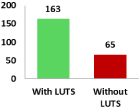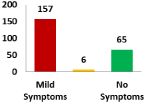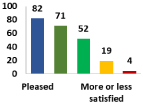Abstract
Background: Benign Prostatic Hyperplasia (BPH) manifests clinically by symptoms of the lower urinary tract. HPB symptoms rarely appear before age 40 but could have a prevalence of 16.6% in men over this age.
Objective: To determine the prevalence and degree of urinary symptoms in patients 40-45 years of age in the Family Medicine Unit #32.
Design and Setting: Descriptive cross-sectional study.
Methods: A descriptive cross-sectional study was conducted, using a non-probabilistic sampling for consecutive cases in a period of time from September to November 2019. The population was men under 45 years old who meet the inclusion criteria. The following variables were collected: age, diabetes mellitus, urinary symptoms, degree of urinary symptoms and quality of life. For statistical analysis, we applied descriptive statistics; for qualitative variables frequencies and percentages were used and for quantitative variables mean and standard deviation with the EPI-INFO version 7 software.
Results: Of the 228 participants, 163 had urinary symptoms; 157 (69%) with mild symptoms and 6 (3%) with moderate symptoms. In quality of life 82% (n=36) of patients were pleased with their current quality of life.
Conclusion: a high percentage of the population presented lower urinary tract symptoms, its evaluation and monitoring is important to prevent urinary diseases.
Keywords: Benign prostatic hyperplasia; Lower urinary tract; International Prostate Symptom Score
Introduction
Benign prostatic hyperplasia (BPH) is currently the most common benign tumor in men [1]. It is a disease with high prevalence that affects 50% of men between 50 and 60 years [2] and more than 90% in men over 80 years [1]. BPH manifests clinically through Lower Urinary Tract Symptoms (LUTS) [2], these symptoms are important for diagnosis although are not exclusive to benign prostatic hyperplasia. LUTS include symptoms of filling, emptying and post-voiding, its most frequent manifestation is mixed although the filling symptoms are the most frequent (nocturnal polyuria and increased frequency in urination) [3]. The spontaneous evolution of BPH, without therapeutic intervention, tends to get worse but slowly and progressively; an early diagnosis is necessary to reduce the impact of the disease as well as its possible complications such as acute urine retention, prostate cancer or kidney failure [4].
One way to objectively measure this type of symptoms is through the International Prostate Symptom Score (IPSS) scale which describes its results as asymptomatic, mild symptomatology, moderate symptomatology and severe symptomatology [5]. Current policies indicate that the digital rectal examination should be performed for all patients with LUTS [6], the suspected diagnosis of benign prostatic hyperplasia based on physical examination and symptomatology has a positive predictive value (PPV) of 69.8% and increases to 77.1% with the prostate specific antigen (PSA). It is suggested to perform prostate antigen only in patients with LUTS suggestive of bladder obstruction secondary to benign prostate growth [6], since it has been shown that there is no statistically significant correlation between prostate volume variables and IPSS score [7].
The prevalence of Benign Prostatic Hyperplasia has increased due to population growth, increased life expectancy and changes in lifestyle [8]. It is a challenge for public health and the symptoms can be very pronounced and limit the patient's quality of life [9]. The use of simple and cheap tools allows the correct evaluation of prostate symptoms and allows to intervene earlier in this group of patients. Based on the above, the main objective of the study was to determine the prevalence, degree of urinary symptoms and quality of life in patients of 40-45 years in the Family Medicine Unit #32, Nuevo Leon, Mexico.
Methods
Study design and population
A descriptive cross-sectional study was conducted in Guadalupe, Nuevo Leon, Mexico, from September to November 2019. The research was carried out in the family medicine unit #32 (FMU 32) of the Instituto Mexicano del Seguro Social (IMSS); a primary care unit. Patients between 40-45 years of age were included. Patients with a history of urinary, renal or prostatic disorders were excluded and patients with incomplete information were eliminated.

Graphic 1: Distribution of Lower Urinary Tract Symptoms.

Graphic 2: Degree of Lower Urinary Tract Symptoms.

Graphic 3: Quality of life according to Lower Urinary Tract Symptoms.
Variables
The variables studied were the following: age, it was measured in years according to the patient's year of birth; presence and degree of lower urinary symptoms, it was measured through the International Prostate Symptom Score (IPSS), an instrument that has eight reagents on Likert scale (0-5 points) where the frequency of the symptoms is evaluated in the last month, 0= never and 5= almost always, the last question (question 8) evaluates the quality of the patient's life with seven possible answers (0= delighted and 7= terrible); Diabetes Mellitus, it presence was evaluated according to electronic medical records.
Statistic analysis
For qualitative variables frequencies and percentages were used; for quantitative variables, mean and standard deviation. For data analysis, the EPI-INFO program version 7, was used.
Ethics
The study was approved by the local health ethics and research committee number 1909; with registration number R-2019-1909-026. The research was conducted under the general health law on health research, the Helsinki declaration and bioethical principles.
Results
228 participants were included who met the selection criteria. The mean age was 42 years; of the sample studied, 163 (71%) showed lower urinary tract symptoms (Graphic 1). The frequency of diabetes mellitus was 34 (15%) and of these patients 82% had urinary symptoms. According to the degree of urinary symptoms, it was found that 157 (69%) have mild symptoms, 6 (3%) moderate symptoms and 65 (28%) have no symptoms (Graphic 2). In the quality of life, 82 (36%) participants are pleased, 71 (31%) delighted, 52 (23%) satisfied, 19 (8%) more or less satisfied and 4 (2%) dissatisfied (Graphic 3).
Discussion and Conclusion
The main objective of this research was to find the frequency of lower urinary tract symptoms in patients aged 40-45 years, the international prostate symptoms scale (IPSS) was used. Of the 228 patients, 163 showed lower urinary tract symptoms, for this reason they are candidates for medical follow-up. The prevalence in Mexico of lower urinary tract symptoms was not found, but a study by Carrero-López in Spain showed a high prevalence of prostatic hyperplasia (16.6%) related to lower urinary symptoms [5]. Lower urinary tract symptoms are not exclusive to BPH since they can be caused by other diseases like obesity and diabetes mellitus. Of the total patients who had Diabetes Mellitus, 82% showed lower urinary tract symptoms.
The IPSS scale is useful for detecting the population at risk, a high percentage of men have lower urinary tract symptoms and for this reason it is important to determine the diseases related to these symptoms. Therefore, strategies to prevent and detect comorbidities in this age group should be created.
References
- Bjerrum T, Gladrow W. Guía Clínica para el Médico, Vinculatoria a la Norma Oficial Mexicana NOM-048-SSA2-2017. Mexico: Secretaria de Salud; 2017.
- Bobé-Armant F, Buil-Arasanz ME, Muñoz GT. Actualización en hiperplasia benigna de próstata. Aten Primaria. 2014; 21: 261-271.
- Brenes-Bermúdez FJ, Brotons-Muntó F, Castiñeiras-Fernández J, Cozar-Olmo JM, Fernández-Ledesma A, Martín-Jiménez JA, et al. Documento de consenso sobre pautas de actuación y seguimiento del varón con síntomas del tracto urinario inferior secundarios a hiperplasia prostática benigna. Semergen. 2016; 42: 547–556.
- Cambronero J, Arlandis S, Errando C, Mora AM. Perfil de síntomas del tracto urinario inferior en el varón y su impacto en la calidad de vida. Actas Urológicas Españolas. 2013; 37: 401–407.
- Carrero-López VM, Cózar-Olmo JM, Miñana-López B. Benign prostatic hyperplasia and lower urinary tract symptoms. A review of current evidence. Actas Urol Esp. 2016; 40: 288–294.
- Carvajal-García R. Relación entre el antígeno prostático específico y la hiperplasia prostática benigna en pacientes mexicanos. Estudio REPSA. Rev Mex Urol. 2014; 74: 342–345.
- Cavelier J. Monografía histórica de la hiperplasia prostática benigna. Med. 1996; 44: 45–66.
- Cózar-Olmo JM, Hernández-Fenández C, Miñana-López B, Amón-Sesmero JH, Montlleó-González M, Rodríguez-Antolín A, et al. Consensus on the clinical impact of the new scientific evidence available on benign prostatic hyperplasia. Actas Urol Esp. 2012; 36: 265–275.
- Errando-Smet C, Müller-Arteaga C, Hernández M, Roset M. Diagnosis and treatment of male patients with lower urinary tract symptoms in Spain - The MERCURY Study. ¿Do urologists follow the recommendations of the European guidelines? Actas Urol Esp. 2018; 42: 323–330.
